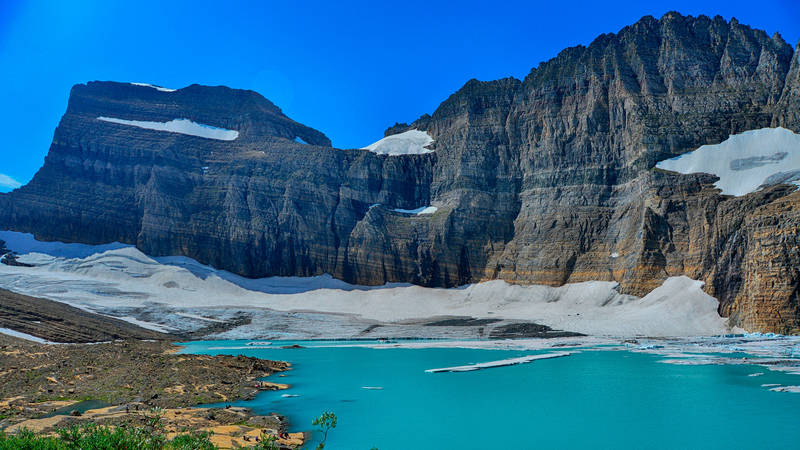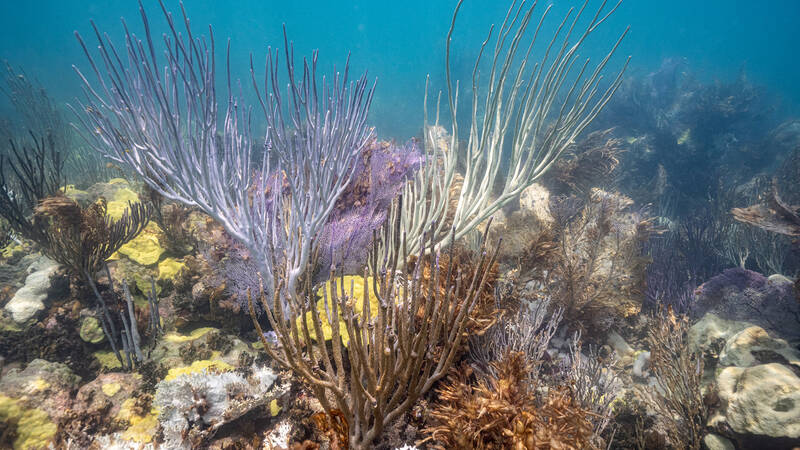From the mountains of Hawaii to East Coast grasslands, infusions of funding from 2022’s Inflation Reduction Act are preparing our national parks to fight the greatest threat to the National Park System: climate change.
The Inflation Reduction Act (IRA) of 2022 was a landmark bill that invested an unprecedented $700 million in national park staffing and infrastructure projects to help parks face the new climate reality.

National Parks Are in Climate Distress. This Law is One Step Toward a Solution.
A year after its passage, 2022’s Inflation Reduction Act remains a historic climate investment in national parks. It can’t be the only one.
See more ›These IRA-funded projects, announced last year, respond directly to Americans’ concerns that if more is not done to address climate change, some of our most treasured and culturally significant national parks as we know them today will be lost. In fact, 4 in 5 Americans support IRA’s funding to the National Park Service to prepare parks from unavoidable floods, fires, droughts and disease caused by climate change. The good news? Since being signed into law, the National Park Service has revealed its plans for 100% of its IRA funding. These resources have allowed parks across the country to plan, schedule and announce work on projects that answer climate science’s call to action and pave the way for climate-conscious restoration and protection from various climate futures.
Learn more about the science-backed solutions that are transforming parks so they can withstand climate impacts.
Fish and Wildlife
Some of the most astonishing experiences in national parks revolve around their distinctive wildlife. Haleakalā National Park in Hawaii is home to a wide range of plants and animals found nowhere else on Earth, including more than 100 that are listed under the Endangered Species Act. That’s more protected species than in any other national park in the country. But because of climate impacts, park plants and animals are more prone to threats sometimes resulting in extinction. This includes the Hawaiian honeycreepers, a group of iconic and endemic bird species found in the park.
Found only on the island of Maui, six Hawaiian honeycreeper species face the threat of extinction within a decade. The most critically endangered species, kiwikiu (also called Maui parrotbill) and ʻākohekohe (also called crested honeycreeper), are only found on the eastern slopes of Haleakalā. A multiagency partnership – Birds Not Mosquitoes – will use $2.9 million in IRA funding to suppress the non-native mosquito population that transmits avian malaria, a disease driving the extinction of these historically and culturally significant birds. In fact, researchers date the arrival of the ancestors of honeycreepers to Hawaii around 5-6 million years ago, when Niʻihau and Kauaʻi, the oldest islands of the current main Hawaiian Islands, were still young and relatively new. The honeycreeper served as a guardian to the Paliuli chiefess, La‘ieikawai.
More than 311 types of invasive species are found in America’s national parks, which threaten wildlife and plants. The invasive hemlock wooly adelgid has killed hemlock trees throughout Shenandoah and Great Smoky Mountains national parks and along the Blue Ridge Parkway. A top predator, the lionfish thrives in Biscayne National Park, negatively affecting native reef fish populations and reef ecosystems. The IRA funds science and research to address threats to endemic species that depend on fragile, carefully balanced habitats, from the Taylor’s checkerspot at Olympic National Park to the Shenandoah salamander at Shenandoah National Park.
Cultural Resources
Weathering, sunlight, moisture and other natural factors have always posed challenges for protecting cultural resources like statues and rare documents at national park sites across the country. But with climate change projections indicating less predictable and more severe weather patterns, including fires and severe drought, historic buildings, landscapes and archaeological sites bear a unique risk.
“The scariest part about cultural resources facing these climate change impacts is that once they’re gone, they’re gone forever,” said Chad Lord, NPCA’s senior director of environmental policy and climate change.

A drilled bone bead found in archeological excavations of a late prehistoric Inupiat village site in Gates of the Arctic National Park and Preserve in 2004.
NPSCultural resources depend on funding and staff to help them withstand climate change. Unlike natural systems, these structures need consistent management that considers the difficult-to-predict climate conditions with the best and most recent science. In rugged Alaska, for example, national parks face the impacts of climate change up to three times faster than the global average. Over $10 million of the parks’ IRA funding will go to Alaska, which has been the homelands of Native people for thousands of generations and holds over 51 million acres of parklands.
$2.5 million has been committed to provide critical care to cultural resources at risk of climate change, such as historic gold mining sites, gravesites, trails and artifacts in Denali, Gates of the Arctic National Park and Preserve, and other Alaska parks. Collaboration with Native Tribes, who rely on park landscapes to practice their traditional culture and subsistence lifeways, is at the heart of these projects.
These infusions of IRA funding will help protect cultural heritage across national park sites by prioritizing those critically threatened resources.
Grasslands and Forests
Grasslands are the most critically imperiled ecosystem in the United States due to the conversion of this ecosystem to other land uses. Yet we need them because they sequester approximately 34% of the global terrestrial carbon stock, prevent soil erosion, enhance water quality, minimize runoff into streams and provide fantastic outdoor recreational opportunities. With funding from the Bipartisan Infrastructure Law and the Inflation Reduction Act, 35 parks from Mississippi to Maine have projects underway to protect this important natural resource. This marks a major win, not just for grasslands but for the numerous species – such as the eastern meadowlark – that depend on them.
At Antietam National Battlefield, Natchez Trace Parkway and New River Gorge National Park and Preserve, grasslands also hold the historical and cultural significance of the Revolutionary and Civil Wars. In Cuyahoga Valley, the IRA funds projects highlighting cultural resources, increasing park accessibility and landscape restoration.
Chris Davis, a plant ecologist in the park, says, “The Inflation Reduction Act funding, really that’s what’s giving us the potential to do this. … We do a pretty good job of internal funding [for] a lot of projects. But we have so much to do. The Inflation Reduction Act funding really has given us the potential to do this project we otherwise could never have done.”

New National Poll Finds Parks Are Political and Physical Solution to Address Climate
“As the worsening climate crisis continues to threaten our health and our communities, this poll shows national parks unite us and offer solutions for addressing it.”
See more ›Americans from both sides of the political aisle have expressed their support for this work. In fact, a 2022 poll by NPCA found a strong bipartisan majority – a whopping 79% of respondents – support funding the National Park Service to rebuild parks with green infrastructure to ensure parks are accessible and enjoyable for generations to come.
“And so … the bipartisan vote for the IRA … [is] validating for people in our industry. They let us know that people are paying attention,” says Crystal Davis, NPCA’s Senior Regional Director of the Midwest. “This is something that should be prioritized, that legislators care about these issues and understand the impact to their constituency.”
These projects across the East ensure this ecosystem is preserved and strengthened so that these important places, and their wildlife and history, can live on.
Coastal Parks
With 88 park sites along our shores, sea level rise combined with more severe and frequent hurricanes and threats to marine life are expected to alter the parks as we know them. And along some of these changing coasts, coral reefs, which exist in 10 national park units, harbor some of the highest biodiversity of any ecosystem. Coral reefs provide homes to about 25% of all known marine species. And the Florida Reef Tract alone protects over 6,000 marine species in a barrier reef ecosystem connecting multiple protected areas, including Biscayne and Dry Tortugas National Parks. In addition, studies by the U.S. Geological Survey and University of California Santa Cruz demonstrated that U.S. coral reefs annually provide flood protection to over 18,000 Americans and $1.8 billion worth of coastal infrastructure.

5 Reasons We Need to Save Our Coral Reefs
Coral reefs help our oceans’ teeming biodiversity survive the impacts of climate change. They also protect communities from severe storms and hurricanes. What happens to corals when 40% of the…
See more ›Just last summer, hot tub temperatures made headlines as 40% of the world’s oceans experienced a marine heat wave and mass coral bleaching. Luckily, over $5 million in IRA funding will support conservation efforts to protect and restore park reefs that support humans and marine life alike. Spanning over 250,000 acres across six parks, this IRA project will improve habitat for imperiled corals, support economically vital species, ensure shoreline protection and contribute significantly to tourism-driven economies. These parks include:
- Biscayne National Park
- Buck Island Reef National Monument
- Dry Tortugas National Park
- Salt River Bay National Historical Park and Ecological Preserve
- Virgin Islands National Park
- Virgin Islands Coral Reef National Monument
“These places are teeming with marine life, but they also protect our communities against disasters and hurricanes,” said Sarah Barmeyer, Deputy Vice President of Conservation Programs. “Seeing these projects focus on what’s within and without parks demonstrates how far we can go when we protect landscapes with the best available science. I don’t know about you, but that gives me hope.”
Parks Can Thrive and Lead the Way
Across the country, the Inflation Reduction Act has presented opportunities national parks have never seen before to address the unprecedented challenges of climate change. To this day, the passage of the IRA marks the most robust climate investment ever made in the National Park System. It is still not enough. As we face the increasingly more frequent and severe climate events – ranging from megafires threatening sequoias to sea level rise overtaking the community where Harriet Tubman spent her childhood – parks need sustained funding and support.
Stay On Top of News
Our email newsletter shares the latest on parks.
“National parks need us more than ever,” Lord said. “To face climate change with our best resources, we need our national parks to thrive and lead the way. When we look at IRA projects, we see some of the first examples of exactly how parks can exemplify meaningful climate action – and just how far funding goes when put in the hands of the National Park Service to help the parks and communities who love them.”
About the author
-
 Lam Ho Senior Climate Communications Manager
Lam Ho Senior Climate Communications ManagerServing as NPCA’s Senior Climate Communications Manager, Lam calls attention to the effects of climate change on public lands with an emphasis on air quality and environmental justice.


